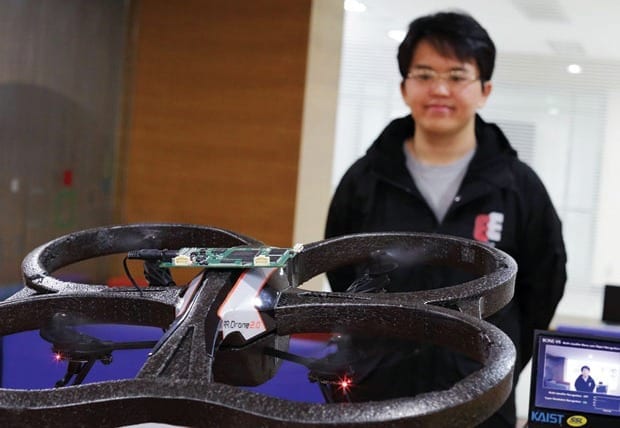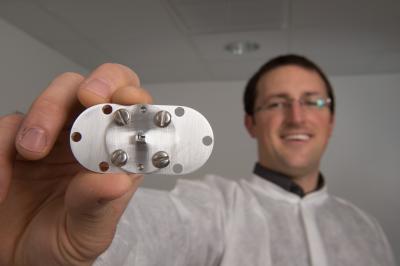
New systems could improve the vision of micro aerial vehicles
Aerial robotics research has brought us flapping hummingbirds, seagulls,bumblebees, and dragonflies. But if these robots are to do anything more than bear a passing resemblance to their animal models, there is one thing they’ll definitely need: better vision.
In February, at the International Solid-State Circuits Conference (ISSCC) in San Francisco, two teams presented new work (PDF) aimed at building better-performing and lower-power vision systems that would help aerial robots navigate and aid them in identifying objects.
Dongsuk Jeon, a graduate student working with Zhengya Zhang and IEEE FellowsDavid Blaauw and Dennis Sylvester at the University of Michigan, in Ann Arbor, outlined an approach to drastically lower the power of the very first stage of any vision system—the feature extractor. That system uses an algorithm to draw out potentially important features like circles and squares from an overall image.
To navigate and to determine whether a scene looks familiar, a micro air vehicle needs to be able to use its entire field of view. But existing full-image feature-extraction algorithms are built to run on desktop computers and servers, not battery-powered platforms, Blaauw says. He adds that although there are some low-power feature-extraction algorithms, those tend to focus on very specific applications such as face recognition.
The Michigan team’s solution was to pare down a traditional feature-extraction algorithm, reengineering it to work well on a specialized image-processing accelerator and optimizing factors like the number of times a portion of an image is accessed for analysis. Image sections in traditional feature extraction may be analyzed a handful of times, because areas of interest often overlap. The new accelerator pushes data through only once, as if the data were on a conveyor belt. “We feed a little bit of the image through a bus, and all the little processors watch,” Blaauw says. “When they see a part of the image they need, they grab it.”
Jeon and his colleagues also incorporated a few hardware tricks to cut down on the power usage. One approach was to rework the shift registers that act as buffers for data that’s in process. Typical shift registers are made up of cells with two latches—circuit components that contain about 10 transistors each. The team found a way to rework the registers so that their cells each contained only one latch. The resulting registers were just as fast, but because they contained half as many latches they lost half as much power from leakage.
The team’s accelerator, which consumes just 2.7 milliwatts of power, was made using a 28-nanometer manufacturing process. The core clocks at a very low 27 megahertz, which keeps the power consumption down; the clock on a typical vision system-on-a-chip works at more than 100 MHz. Although feature extraction is just one aspect of vision systems, Jeon says, it can take up as much as 70 percent of the area of the core on a vision chip.
Another approach, led by IEEE Fellow Hoi-Jun Yoo at the Korea Advanced Institute of Science and Technology (KAIST) in Daejeon, South Korea, is to attack the vision problem at the complete chip level. Yoo’s team has built an SoC with 21 image-processing cores. The chip, which has been demonstrated on a toy car and on a four-propeller flying robot called a quadrotor, is capable of distinguishing faces and differentiating between objects and pictures of objects—for instance, a car and a billboard carrying the image of a car.
The Latest Bing News on:
Flying Robots
- Futuristic cruise ship has robot bartenders that can make 1,000 drinks a dayon May 9, 2024 at 8:43 am
The cruise company features robotic bartenders on nine of its 28 ships, with two Makr Shakr machines in each Bionic Bar shaking and stirring up to 1,000 drinks every day.
- Quarter-sized hail expected with tornado in DeKalb and Jackson counties Thursdayon May 9, 2024 at 8:19 am
The National Weather Service issued a tornado warning at 8:08 a.m. on Thursday in effect until 8:45 a.m. for DeKalb and Jackson counties.
- Lucid Bots secures $9M for drones to clean more than your windowson May 8, 2024 at 10:56 am
Cleaning the outside of buildings is a dirty job, and it’s also dangerous. Lucid Bots came on the scene in 2018 with its Sherpa line of drones to clean ...
- Swarm of tiny snail robots stick together to form new structureson May 8, 2024 at 6:15 am
Researchers have built a swarm of miniature, snail-inspired robots, minus all the mucus. Instead, a retractable suction cup works in tandem with the remote-controlled machine’s tank-like treads to ...
- Scientists create robot snails that can move independently using tracks or work together to climbon May 7, 2024 at 6:00 am
A team of roboticists at the Chinese University of Hong Kong has created a robot snail with a helmet-like shell that moves by rolling around on bulldozer-like tracks. They have published a paper on ...
- Shhh! 3 Secret Robotics Stocks Flying Below Wall Street’s Radaron May 4, 2024 at 7:00 am
InvestorPlace - Stock Market News, Stock Advice & Trading Tips Robotics stocks are leading today’s tech frontier. There are very few ...
- Scientists unveil giant robot bees that can fly and SWARM in groups autonomouslyon May 2, 2024 at 7:14 am
SCIENTISTS are creating a buzz after unveiling a giant robotic bee that can fly in a swarm. The so-called BionicBee measures 22cm long and weighs less than a typical slice of bread. And it can ...
- TUM Professor Utilizes ChatGPT for Choreographing Flying Robotson April 30, 2024 at 7:15 pm
Doctoral student Martin Schuck selects a music track and enters a text requesting a suggested choreography. Additional instructions can be given to the drone swarm via another prompt in the ChatGPT to ...
- ChatGPT Is Choreographing Flying Robots—But How?on April 30, 2024 at 1:32 am
In a pioneering endeavor led by Prof. Angela Schoellig from the Technical University of Munich (TUM), ChatGPT is utilized to orchestrate synchronized aerial performances of drone swarms to musical ...
- Researchers use ChatGPT for choreographies with flying robotson April 29, 2024 at 11:57 am
Angela Schoellig from the Technical University of Munich (TUM) uses ChatGPT to develop choreographies for swarms of drones to perform along to music. An additional safety filter prevents mid-air ...
The Latest Google Headlines on:
Flying Robots
[google_news title=”” keyword=”Flying Robots” num_posts=”10″ blurb_length=”0″ show_thumb=”left”] [/vc_column_text]The Latest Bing News on:
Robot vision
- U.S. Marine Special Operations Testing Armed Robotic Canines: The New Vanguard of Battlefield Technologyon May 9, 2024 at 7:54 am
U.S. Marine Special Operations Testing Armed Robotic Canines: The New Vanguard of Battlefield Technology ...
- Robotic system feeds people with severe mobility limitationson May 9, 2024 at 7:13 am
Cornell researchers have developed a robotic feeding system that uses computer vision, machine learning and multimodal sensing to safely feed people with severe mobility limitations, including those ...
- A Booth Visit with Yaskawa at Automate 2024: Two Vision System Applicationson May 9, 2024 at 7:05 am
The demo featured a Keyence 3D vision system and relied on a predefined CAD model of the parts. An image sensor located above the cell projected light and detected objects contained in the bin. “With ...
- Drone Leader Nightingale Security and AITX’s Robotic Assistance Devices Announce Global Reach with Targeted Autonomous Security Solutionson May 9, 2024 at 7:03 am
The partners are committed to a long-term vision with typically three-year Robotics-as-a-Service (RaaS) contracts, underscoring their dedication to providing sustained, innovative security solutions ...
- Simbe partners with Plexus to scale Tally inventory roboton May 9, 2024 at 6:52 am
Simbe Robotics, which said it recorded a 3x increase in its subscription revenue in 2023, is scaling production of its Tally inventory robot.
- Robot Operating System Market: Projected Surge to US$ 490.3 Million by 2033, Propelled by a 5.7% CAGRon May 8, 2024 at 7:47 pm
The worldwide robot operating systems market was worth approximately US$ 249.2 million in 2021. Over the next decade, it is expected to grow at an average annual rate of 5.7%. By 2033, it is ...
- 1st LA-area patient undergoes surgery using Da Vinci 5, the most advanced form of robotic surgeryon May 8, 2024 at 2:44 pm
Adventist Health Simi Valley is one of only 10 hospitals nationwide offering the new Da Vinci 5 robotic surgery technology.
- Five Things to Consider Before Adopting Robotics for Warehouse Automationon May 8, 2024 at 10:54 am
Modern retailers have an incredible opportunity to futureproof their warehouse operations today, with the goal of increasing efficiency to meet this surging consumer demand.
- Techman Robot Unveils New High-payload AI Cobot TM30S at Automateon May 8, 2024 at 7:17 am
The TM30S is an extension of the TM AI cobot series, now catering to even higher payloads. With the ability to carry up to 35kg and boasting a reach of 1702mm across six joints, t ...
- Hugging Face launches LeRobot open source robotics code libraryon May 6, 2024 at 12:56 pm
An open-source toolkit designed to democratize AI robotics and inspire a new generation of roboticists, available now on Github.
The Latest Google Headlines on:
Robot vision
[google_news title=”” keyword=”robot vision” num_posts=”10″ blurb_length=”0″ show_thumb=”left”]










